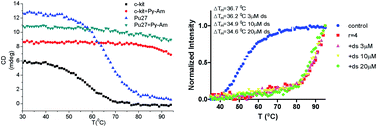G-Quadruplexes formed by G-rich DNA are of broad interest due to their involvement in telomere function, gene transcription and recombination. Small ligands that interact strongly with G-quadruplexes have been considered to further influence telomeric function and gene transcription. Because most G-rich sequences are trapped in duplex structures in gene promoters, ligands that can stabilize G-quadruplexes in the presence of their complimentary strands would likely have strong effects on gene transcription. Here, we report a novel simple small molecule (pyridyl carboxamide), consisting of three pyridine rings and four amide bonds. Comparing with some reported G-quadruplex ligands, this molecule not only selectively stabilizes G-quadruplexes rather than duplexes, but also maintains a G-quadruplex structure even if the G-rich region was trapped in long double-stranded DNA (dsDNA). It is widely believed that the dissociation of duplexes is involved in gene transcription and that the formation of the G-quadruplex influences some oncogene expression. Py-Am exhibited strong G-quadruplex-forming ability within a long dsDNA sequence, suggesting it would have potent effects on the G-quadruplex-forming sequences involved in gene transcription.

You have access to this article
 Please wait while we load your content...
Something went wrong. Try again?
Please wait while we load your content...
Something went wrong. Try again?


 Please wait while we load your content...
Please wait while we load your content...